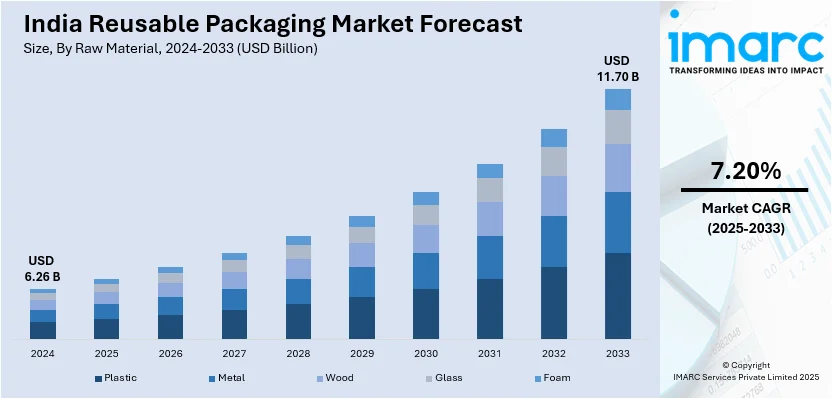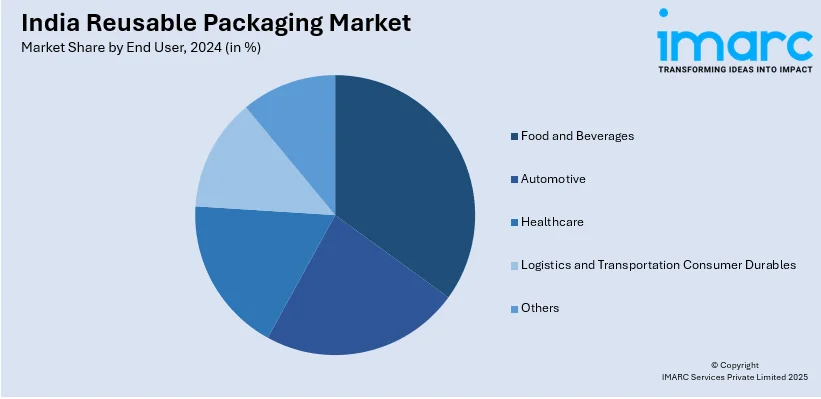
India Reusable Packaging Market Size, Share, Trends and Forecast by Raw Material, Type, End User, and Region, 2025-2033
India Reusable Packaging Market Overview:
The India reusable packaging market size reached USD 6.26 Billion in 2024. Looking forward, IMARC Group expects the market to reach USD 11.70 Billion by 2033, exhibiting a growth rate (CAGR) of 7.20% during 2025-2033. The market is driven by growing environmental concerns and government regulations promoting sustainable packaging solutions. Increasing consumer awareness, coupled with the expansion of e-commerce and retail sectors, fuels demand for durable and cost-effective reusable packaging. Additionally, corporate sustainability initiatives and advancements in material innovation further accelerate the market growth.
|
Report Attribute
|
Key Statistics
|
|---|---|
|
Base Year
|
2024 |
|
Forecast Years
|
2025-2033
|
|
Historical Years
|
2019-2024
|
| Market Size in 2024 | USD 6.26 Billion |
| Market Forecast in 2033 | USD 11.70 Billion |
| Market Growth Rate 2025-2033 | 7.20% |
India Reusable Packaging Market Trends:
Rising Adoption of Circular Economy Practices
The transition to a circular economy is fueling tremendous transformation in India's reusable packaging industry. Companies are increasingly turning their attention to waste reduction by adopting closed-loop systems where packaging materials are collected, sanitized, and reused several times. Government policies, including the Plastic Waste Management Rules, promote companies to use sustainable packaging solutions, further propelling the need for reusable options. Those in the food and beverage (F&B), consumer packaged goods, and e-commerce industries are pursuing reusable packaging models actively as a means of embracing sustainability objectives and regulatory expectations. Technological developments in material science, i.e., biodegradable and recyclable polymers, improve the strength and performance of reusable packaging to make it a viable option compared to single-use plastic and traditional disposable packaging options.

To get more information on this market, Request Sample
Growth of E-Commerce and Logistics Sector
The fast growth of India's e-commerce and logistics industry is driving the demand for reusable packaging. As online shopping increases, businesses are looking for cost-effective and eco-friendly packaging solutions to minimize waste and optimize supply chain efficiency. Large e-commerce players and third-party logistics companies are adopting returnable packaging solutions like reusable crates, bins, and bulk containers to save on packaging costs and maximize operational sustainability. Furthermore, reusable packaging assists in mitigating issues of unnecessary plastic waste created by single-use delivery packaging. Subscription and rental packaging models are increasingly popular, enabling companies to implement reusable alternatives without significant initial investments. Emphasis on maximizing reverse logistics infrastructure further speeds up the use of reusable packaging throughout the industry.
Advancements in Smart and Traceable Packaging
India's packaging industry is growing rapidly at an annual rate of 12%, creating a strong foundation for adopting smart technologies in reusable packaging. Companies are increasingly integrating innovations like Radio-Frequency Identification (RFID), quick response (QR) codes, and Intent of Things (IoT)-enabled tracking systems to enhance supply chain transparency and optimize asset management. These technologies help monitor packaging usage, track returnable assets, and extend their lifecycle, reducing costs and losses. Demand for intelligent reusable packaging is rising in industries such as pharmaceuticals, retail, and food delivery, where real-time monitoring of temperature, humidity, and handling conditions is essential. Additionally, blockchain adoption in supply chains is strengthening authentication and traceability, making reusable packaging a secure, efficient, and sustainable solution for businesses striving for long-term environmental and economic benefits.
India Reusable Packaging Market Segmentation:
IMARC Group provides an analysis of the key trends in each segment of the market, along with forecasts at the country level for 2025-2033. Our report has categorized the market based on raw material, type and end user.
Raw Material Insights:
- Plastic
- Metal
- Wood
- Glass
- Foam
The report has provided a detailed breakup and analysis of the market based on the raw material. This includes plastic, metal, wood, glass, and foam.
Type Insights:
- Pallets
- Crates
- Dunnage
- Intermediate Bulk Containers
- Bottles
- Drums and Barrels
- Others
A detailed breakup and analysis of the market based on the type have also been provided in the report. This includes pallets, crates, dunnage, intermediate bulk containers, bottles, drums and barrels, and others.
End User Insights:

- Food and Beverages
- Automotive
- Healthcare
- Logistics and Transportation Consumer Durables
- Others
The report has provided a detailed breakup and analysis of the market based on the end user. This includes food and beverages, automotive, healthcare, logistics and transportation consumer durables, and others.
Regional Insights:
- North India
- South India
- East India
- West India
The report has also provided a comprehensive analysis of all the major regional markets, which include North, South, East, and West India.
Competitive Landscape:
The market research report has also provided a comprehensive analysis of the competitive landscape. Competitive analysis such as market structure, key player positioning, top winning strategies, competitive dashboard, and company evaluation quadrant has been covered in the report. Also, detailed profiles of all major companies have been provided.
India Reusable Packaging Market News:
- In October 2024, Eco-Products introduced Veda™, a new line of durable, reusable foodservice containers designed for closed-system environments like universities, corporate campuses, and hospitals. Featuring OZZI®'s proprietary tracking and collection technology, the containers enable easy return, washing, and reuse. Supported by Novolex’s investment in OZZI, this initiative enhances waste diversion efforts and promotes sustainable packaging solutions.
- In September 2025, Array Technologies introduced a reusable packaging solution to reduce waste and enhance sustainability in solar tracker transportation. Replacing traditional cardboard with durable plastic casings, the solution maximizes shipping efficiency by allowing more materials per pallet. With a lifespan of up to 15 years, the bulk packaging aims to improve logistics and environmental impact for utility-scale solar projects.
India Reusable Packaging Market Report Coverage:
| Report Features | Details |
|---|---|
| Base Year of the Analysis | 2024 |
| Historical Period | 2019-2024 |
| Forecast Period | 2025-2033 |
| Units | Billion USD |
| Scope of the Report | Exploration of Historical Trends and Market Outlook, Industry Catalysts and Challenges, Segment-Wise Historical and Future Market Assessment:
|
| Raw Materials Covered | Plastic, Metal, Wood, Glass, Foam |
| Types Covered | Pallets, Crates, Dunnage, Intermediate Bulk Containers, Bottles, Drums and Barrels, Others |
| End Users Covered | Food and Beverages, Automotive, Healthcare, Logistics and Transportation Consumer Durables, Others |
| Regions Covered | North India, South India, East India, West India |
| Customization Scope | 10% Free Customization |
| Post-Sale Analyst Support | 10-12 Weeks |
| Delivery Format | PDF and Excel through Email (We can also provide the editable version of the report in PPT/Word format on special request) |
Key Benefits for Stakeholders:
- IMARC’s industry report offers a comprehensive quantitative analysis of various market segments, historical and current market trends, market forecasts, and dynamics of the India reusable packaging market from 2019-2033.
- The research report provides the latest information on the market drivers, challenges, and opportunities in the India reusable packaging market.
- Porter's five forces analysis assist stakeholders in assessing the impact of new entrants, competitive rivalry, supplier power, buyer power, and the threat of substitution. It helps stakeholders to analyze the level of competition within the India reusable packaging industry and its attractiveness.
- Competitive landscape allows stakeholders to understand their competitive environment and provides an insight into the current positions of key players in the market.
Key Questions Answered in This Report
The reusable packaging market in India was valued at USD 6.26 Billion in 2024.
The India reusable packaging market is projected to exhibit a CAGR of 7.20% during 2025-2033, reaching a value of USD 11.70 Billion by 2033.
The India reusable packaging market is driven by growing environmental concerns, government regulations on plastic waste, rising corporate sustainability initiatives, and cost-effectiveness over single-use packaging. Increasing consumer awareness, expansion of e-commerce, and adoption by FMCG, food, and logistics sectors further boost demand, promoting circular economy practices and reducing environmental impact.
Need more help?
- Speak to our experienced analysts for insights on the current market scenarios.
- Include additional segments and countries to customize the report as per your requirement.
- Gain an unparalleled competitive advantage in your domain by understanding how to utilize the report and positively impacting your operations and revenue.
- For further assistance, please connect with our analysts.
 Request Customization
Request Customization
 Speak to an Analyst
Speak to an Analyst
 Request Brochure
Request Brochure
 Inquire Before Buying
Inquire Before Buying




.webp)




.webp)












